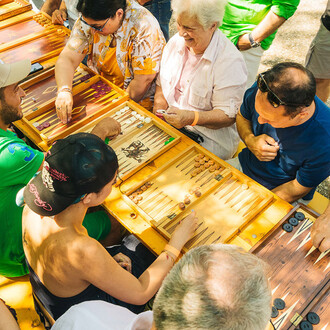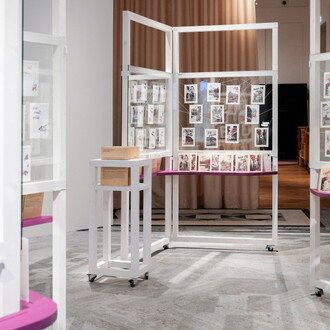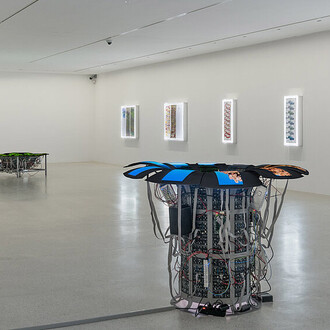The subject of friendship is thoroughly existential and timeless, cutting to the bone of human existence. A theme that spans all historical periods and across all regions of the world. At the same time, the subject seems particularly relevant right now: In light of the threatening state of the world, the countless crises, conflicts, and increasing social divisions, Dom Museum Wien’s decision to dedicate this exhibition to a conciliatory interpersonal subject is all the more important.
“In times when polarization in politics, society, and social media as well as rampant egotism on Instagram and its ilk are more and more palpable, we felt it important to conceive an exhibition at Dom Museum Wien that placed connective elements, the give-and-take of me-and-you, and the dialogical principle front and center”, says museum director Johanna Schwanberg, who curated the exhibition together with co-curator Klaus Speidel. The exhibition title deliberately shies away from purely positive, often idealized connotations of the word “friendship” as the harmony of two souls, to signalize that this is no romanticized “sunshine-and-rainbows” presentation. In the spirit of friendship also addresses problematic aspects related to this type of relationship.
Friendship is a basic human need: relationships with others, spiritual closeness, and chosen family shape our lives. The exhibition deals with the universal meaning of friendship as part of human social interaction - on a personal or political level. Facets of friendship are explored via graphics, painting, sculpture, photography, video, and installation art. In addition to national and international loans and new commissioned works, the exhibition also offers insights into the collections of Dom Museum Wien.
Dom Museum Wien is an ideal venue to illuminate this existential subject in a meaningful way: Friendship as a mentality is closely related to the Christian background of the museum’s historic sacred treasures. “The history of religion permeates the awareness of the infinite distance between the human and the divine, which actually makes the idea of real friendship with gods, with God, impossible. What’s so compelling about Judaism and, later, Christianity is the idea of the bond God creates with humans. This bond is one of friendship”, says Cardinal Christoph Schönborn in an interview in the exhibition catalogue.
Like in all preceding special exhibitions at Dom Museum Wien since its reopening in 2017, In the spirit of friendship doesn’t tell a chronological story but rather uses contrasts and juxtapositions of works from various periods of art history. The sculptures, paintings, drawings, photographs, and video installations span a historical arc from the Middle Ages to the present day. The selection comprises works from the historic holdings of the museum and the Otto Mauer Contemporary Collection as well as high-caliber loans from national and international collections, museums, abbeys, and galleries. The exhibition also incorporates several site-specific commissions and new acquisitions from numerous contemporary artists.
The participative installation Studio supplement by Vienna-based artist Marlene Fröhlich was commissioned for the show. The many small black-and-white photographs on the wall seem like they’ve been taken out of an old family album, but they are, in fact, AI-generated images that have been produced using analog techniques. They counterbalance a heteronormative idea of friendship and love, urging us to think about the power of images as well as the necessity for developing alternative narratives. The work itself is subject to a constant process of change. In the wall-mounted adjacent mailbox, visitors can deposit their contributions on which friendship scenes they consider to be missing from history and the present. Selected examples will be integrated into the installation during the run of the exhibition, replacing others.
Robin Waart produced 16 postcards with film stills of friendship scenes taken from movies of different decades. The subtitles visible on the stills, such as “You’re my friend to the end” or “You’ll make lots of friends”, speak to the emotions, yearnings, and ideals related to friendship. Its participative character is a unique aspect of this work, as visitors can take the postcards home, write on them, send them to friends—creating a link between the museum space and real friendship practices.
A large scale paper collage by Susanna Inglada, a wall-spanning drawing by Juliette Green, in which she imagines different answers to the question “What is the biggest difference between you and your closest friend?” in the form of narrative charts, and bronze–textile sculptures by artist Lisa Großkopf were also created specifically for this show at Dom Museum Wien.
The exhibition includes work by Theodore Alconiere, Christian Ludwig Attersee, Jean Béraud, Ákos Birkás, Pierre Bismuth, Günter Brus, Annibale Carracci, Claude Closky, Die Damen, Peter Fendi, Heribert Friedl, Marlene Fröhlich, Helene Funke, Gustav Gaul, Gelitin/Gelatin, Dorothee Golz, Juliette Green, Lisa Großkopf, Nick Hagen, Robert Hammerstiel, Xenia Hausner, Bettina Hutschek, Susanna Inglada, Franz Christoph Janneck, Leander Kaiser, Dejan Kaludjerović, Barbara Kapusta, Oleg Karpov, Mayya Kelova, Anders Krisár, Maria Lassnig, Thomas Lévy-Lasne, Master of the Albrecht Altar, Carl von Merode, Johann Josef Mildner, Tracey Moffatt, Nicola Muirhead, Muntean/ Rosenblum, Hermann Nitsch, Matthias Noggler, Lisl Ponger, Arnulf Rainer, Dieter Roth, Gerhard Rühm, Maruša Sagadin, Alessandra Sanguinetti, Hans Schäufelein, Dominik Steiger, Gudmund Stenersen, Johann Till the Younger, Switzin Twikirize, Tanzio da Varallo, Robin Waart, Nives Widauer, Oswald Wiener, Carina Yepez, Yuge Zhou, and historic artists whose names have not been handed down.
A catalogue accompanying the exhibition is available, with an introduction by Johanna Schwanberg, an essay by Daniel Tyradellis, as well as interviews with Cardinal Christoph Schönborn and Janosch Schobin.
The exhibition focuses on five main themes. They are Between intimacy and distance, Acting together, being together, Building teams, forming alliances, Working together, making a difference, and Creating rituals, setting examples, approaching the subject from different directions: from the vantage points of history and the present day, and by artists of various geographic, cultural, ethnic, social, and gender backgrounds.
For the first time, the outdoor area of Dom Museum Wien will also be part of the exhibition: the 6-meter-long friendship bench Doris (2016) by Otto-Mauer-Prize recipient Maruša Sagadin invites visitors to linger and chat in the museum courtyard between Stephansplatz and Wollzeile.
The museum’s round stairwell entrance with its striking spiral staircase and glass elevator also puts visitors in a mood of friendship: 30 colorful image panels by artist Heribert Friedl scattered across the large white wall profess intimate thoughts and confessions of amicable affection and individual phrases like “I am part of you”, “I am behind you all the time”, and “understanding”. The genre of the devotional image, the medieval-looking font—and the artist’s deliberate omission of figural presentations and concrete references to other content make sure that nothing stands in the way of the complete interpretive openness of the poems.
In contrast to previous exhibitions at Dom Museum Wien, this show includes a larger number of handcrafted items and everyday objects, such as vintage greeting cards, autograph books, and friendship cups. This also has to do with the fact that over the centuries, friendship has manifested primarily in objects and rituals of everyday life as well as in written documents like letters and postcards—and not predominantly works of art.
While the historic works are all by male artists, it was crucial to the curatorial concept to show many contemporary works by women artists, such as Helene Funke, Maria Lassnig, Die Damen, Dorothee Golz, Mayya Kelova, Nicola Muirhead, and others.
The Eurocentric gaze that prevails especially in historic and avant-garde works, is somewhat expanded by incorporating contemporary positions from different parts of the world: Tracey Moffatt from Australia, Switzin Twikirize from Uganda, Yuge Zhou from China, and Oleg Karpov from Uzbekistan.
The exhibition poster and key visual is by American Argentinian contemporary photographer Alessandra Sanguinetti: Las pastorcitas (The shepherds, 1998) exudes positive energy and communicates the theme of the show in a direct and unambiguous way. The two girls embracing in a vast rural landscape are cousins and best friends Guillermina Aranciaga and Belinda Stutz. Sanguinetti accompanied the pair for decades, creating an arresting example of how art is able to visualize friendship as a phenomenon unfolding over a period of time.
As in all exhibitions at Dom Museum Wien, a high value is placed on establishing a relationship between the museum world and the living realities of our diverse audiences in art-education and joint projects with educational and social institutions. The format Alle unter einem dach (All under one roof) was developed in conjunction with the Viennese association Nachbarinnen, in which women of different linguistic and cultural backgrounds visit the exhibition together with native speakers. They try out ways of expressing themselves creatively, verbally, and physically in a group—and can perhaps make new friends along the way.
Between intimacy and distance
The first exhibition space, spanning 2 rooms, explores the vast theme of friendly duos—the relationship of emotional and/or physical distance and closeness. The video piece, Love letters (summer) (2020) by the Chinese-born, U.S.-based artist Yuge Zhou, shows a split-screen of two people on opposite sides of the Chicago River communicating with each other nonverbally using dance movements despite the water that separates them. An intimate connection is also shared by the two women on the brightly colored painting Connected by the roots by Ugandan artist Switzin Twikirize, as well as by the two young men in the painting Everyone has one idea of freedom that allows no one else to have another (2001) by Muntean/Rosenblum. The sculpture Bronze/wax #1 (2005/06) by Anders Krisár reminds us that getting too close to another person can be toxic and may lead to the disintegration of one’s own identity. The piece consists of two heads facing each other; one is made of bronze, the other of wax. The bronze head is equipped with a heat plate and has visibly damaged the wax face. Symbiosis versus boundaries is also the subject of the seemingly surreal sculptural table object Indivisible togetherness (2004) by the artist Dorothee Golz: A set table with facing chairs. The ostensibly mundane situation is nevertheless somewhat jarring, especially when we realize that the two seats and the tableware are merged into an inseparable unit, making it virtually impossible for friends to sit together at the table. Important historic objects featuring biblical tales of friendship, like Annibale Carracci’s Christ and the samaritan woman at the well (c. 1604/05), an anonymous Visitation from the Diocesan Museum of Brixen (c. 1440–1450), and The road to Emmaus (1888) by Johann Till the Younger, convey that friends sticking together is an essential theme in all situations, all social strata, and across all ages—albeit with different characteristics.
Acting together, being together
The next part of the exhibition negotiates the relevance of friendly networks and larger groups of friends. Works by artists from various periods, among them Franz Christoph Janneck, Gudmund Stenersen, Helene Funke, Juliette Green, Matthias Noggler, Xenia Hausner, Nick Hagen, and Thomas Lévy-Lasne, visualize how friendship is shaped by joint activities, common interests, or shared values—be it in the public or the private sphere, in the great outdoors, or in cultural institutions like the opera or the theater.
Building teams, forming alliances
The personal and sociopolitical opportunities and risks that accompany networks of friends characterize the third part of this exhibition. A medieval rendering of Christ on the mount of olives (c. 1470) tells the story of Jesus - in full knowledge of his impending death - asking his disciple friends to hold vigil and pray with him on the night before. The work also demonstrates what it means to be abandoned by one’s friends: Christ’s friends keep falling asleep, and in the background, we witness the betrayal of a friend, as Judas turns Jesus in to his enemies.
Jean Béraud’s At the club (1904), is a critical and profoundly humorous painting that presents a group of elegantly dressed men submerged in their armchairs in a typical early twentieth-century gentlemen’s club. Paired with Lisl Ponger’s Otaheite olé, which shows chummy white men divvying up their wealth, power, and properties among each other, it addresses a fraught chapter in the history of friendship. Works by Maria Lassnig, Carl von Merode, Tracey Moffatt, and Uzbek artist Oleg Karpov look at networks as different kinds of existential alliances. In his installation, Jungle book project (2002), French artist Pierre Bismuth has allocated a different language to each of the famous Disney film’s characters. What’s striking about this project is that while the characters don’t speak the same language, the communication between them is still flawless: friendly coexistence despite cultural and linguistic barriers.
Working together, making a difference
The next part of the exhibition tackles the relevance of friendship in creative processes by looking at a nineteenth-century group portrait of artists by Gustav Gaul, collaborative works by Günter Brus and his avantgarde artist friends, a photograph by the feminist group Die Damen from the 1980s, a plasticine image by the contemporary collective Gelitin/Gelatin, and a text-based piece by the contemporary artist Claude Closky. The artworks broach many aspects of friendship and artistic production. They also illustrate how important it is to work collectively for longer periods of time, addressing the value of joint public appearances to become more influential in a community or society.
Creating rituals, setting examples
The next chapter is devoted to the practice of friendship, the representation of friendship in images and objects, and the ritual and symbolic acts people have developed and honed to make friendship manifest. Besides Biedermeier friendship cups and greeting cards as well as autograph books, contemporary pieces by Marlene Fröhlich, Lisa Großkopf, Robin Waart, Nives Widauer, and Carina Yepez raise questions as to which images, symbols, and materials are used to depict (or not depict) real friendships.
Finally, the large scale paper collage by Susanna Inglada depicting a wildly entangled group of friends leaves a haunting impression. The striking multipart paper installation in charcoal and acrylic by the Spanish artist, shows a group of entangled people frozen in an expressive gesture. Also mounted on the wall are outsized braids and interlocking hands (an image of these hands also adorns the museum’s Stephansplatz-facing façade). Whether the members of this collective are supporting each other in joyful, friendly celebration or whether what is depicted is a struggle for supremacy within a group of friends or enemies, remains open to interpretation.
Inglada’s piece ushers visitors back through the permanent exhibition, to an intimate space with a view of Stephansplatz. The artist Dejan Kaludjerović has created an audiovisual installation that is based on interviews with children from various cultural backgrounds in different languages. The piece addresses the common and divergent ideas, dreams, and realities of friendships between girls and boys from different parts of the world.
With loans from Belvedere, Wien; Pierre Bismuth; Günter Brus; Charim Galerie; Christine König Galerie, Wien; Collection Justine Triet; Collection Nicolas Rennert, unconditional friend of the artist; Collection Sophie Fillières, Collection Vincent Di Rosa, Collection VR d’Affaux Foundation, Paris, France; Die Damen; Diocesan Museum of Brixen; Archbishopric of Vienna; Marlene Fröhlich; Galerie Laurent Godin, Paris; Galerie Maurits van de Laar; Galerie Mehdi Chouakri, Berlin; Galerie Meyer*kainer, Wien; Gianni Manhattan, Vienna; Juliette Green © Adagp, Paris, 2024; Lisa Großkopf; Nick Hagen; Hidden Collection; Susanna Inglada; J. and L. Lobmeyr; Jüdisches Museum Wien; Dejan Kaludjerović; Oleg Karpov; Mayya Kelova; Kunsthistorisches Museum Wien, Gemäldegalerie; Koch Family Collection; Anders Krisár; Kultumuseum Graz; Lentos Kunstmuseum Linz; Liechtenstein. The Princely Collections, Vaduz–Vienna; Maria Lassnig Foundation; Nicola Muirhead; mumok – Museum moderner Kunst Stiftung Ludwig Wien; Parish of St. Ruprecht, Vienna; Maruša Sagadin; Sammlung Frauennachlässe, Department of History, University of Vienna; Heinrich und Elisabeth Schuschnigg Collection; Alessandra Sanguinetti / Magnum Photos; Soace, London; Strabag ArtCollection, Vienna; Szépművészeti Múzeum / Museum of Fine Arts, Budapest; Robin Waart; Wien Museum; Yuge Zhou; Cistercian Monastery Heiligenkreuz Abbey - Art Collection.
Together with Wiener Städtische Versicherung, Wiener Städtische Versicherungsverein is one of the close partners of the exhibition In the spirit of friendship. “Dom Museum Wien’s outstanding exhibitions impress us with their aesthetic experiences as well as with their meaningful artistic exploration of socially important and complex topics. The museum’s incredibly well curated exhibitions help to promote understanding as well as enjoyment of art and culture. As a long-standing partner - and friend - of Dom Museum Wien, we are delighted to support In the spirit of friendship", says Robert Lasshofer, Chairman of the Board of Wiener Städtische Versicherungsverein, main shareholder of the Vienna Insurance Group (VIG).
“Art and culture make our society look at things from a new perspective every day. As a company that constantly questions itself and its impact on its environment, we are keenly aware of our responsibility. The new exhibition In the spirit of friendship looks at the connections, the relationships, the commonalities, precisely those aspects that also affect an insurance company like Wiener Städtische. We are therefore very pleased and proud to support this show at Dom Museum Wien", says Doris Wendler, Board Director of Wiener Städtische Versicherung.
- Curator: Johanna Schwanberg.
- Co-curator: Klaus Speidel.
- Curatorial assistants: Anke Wiedmann, Nina Schermann.
















